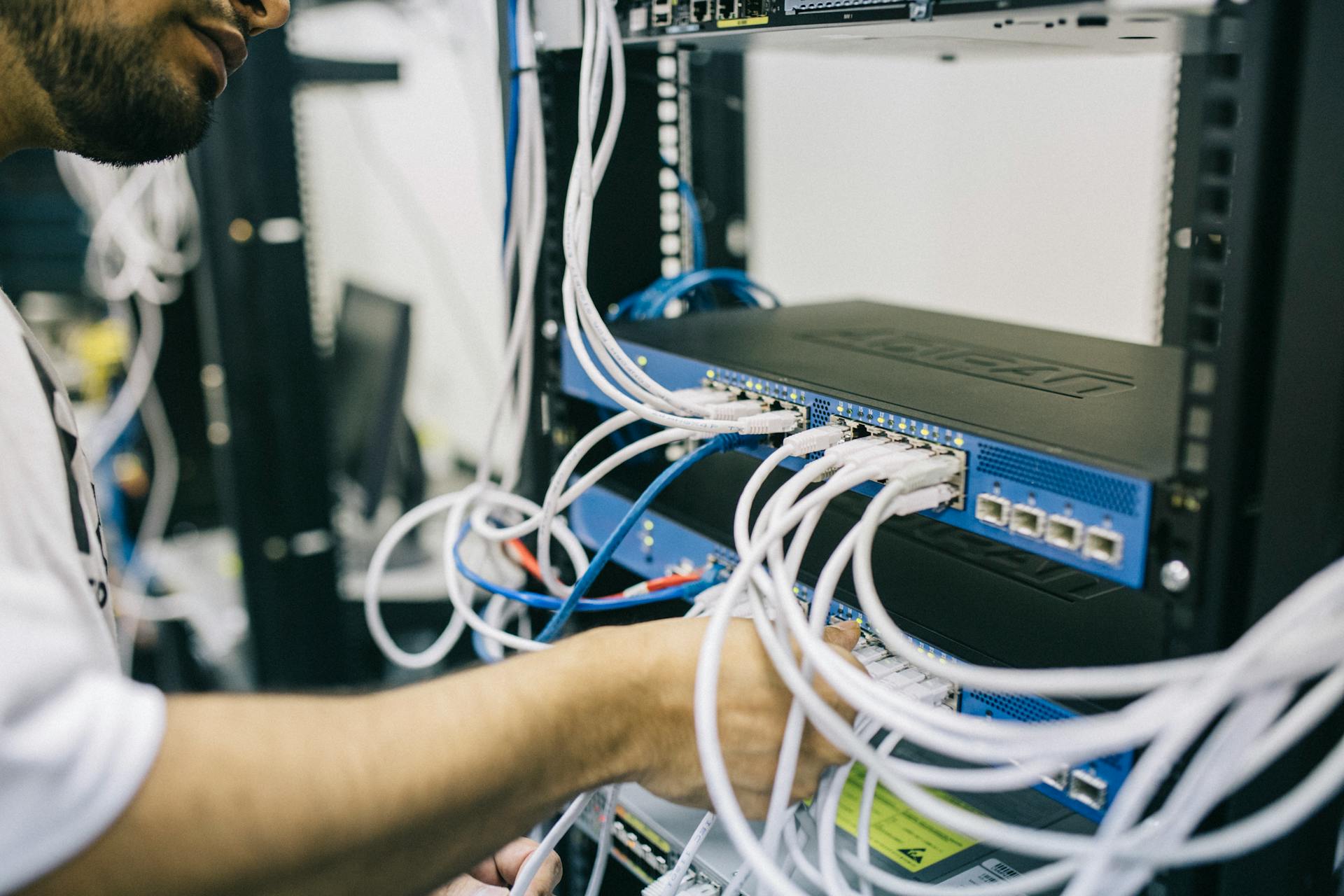
To achieve PCI compliance, payment processors must meet specific requirements, including implementing robust security measures and regular vulnerability scans.
The Payment Card Industry Data Security Standard (PCI DSS) is the framework for these requirements, which is maintained by the Payment Card Industry Security Standards Council.
Payment processors must also have a clear incident response plan in place to handle potential security breaches.
This plan should include procedures for containment, eradication, recovery, and post-incident activities.
Readers also liked: Security Metrics Pci Compliance Cost
What Is PCI Compliance?
PCI compliance is a must for any company or organization that accepts, transmits, or stores private data of cardholders.
The Payment Card Industry Security Standards Council outlines various security measures to ensure this data is kept safe and private.
To be PCI compliant, an organization must meet the security requirements and access control measures mandated by the Data Security Standards (DSS).
This includes considering information security policies, such as physical access, authentication data, validation, and transmission of card data over public networks.
Secure network configuration and management is key to protecting sensitive data.
The level of PCI DSS compliance an organization needs to meet depends on the number of card transactions it processes annually.
More transactions require more stringent compliance, and some organizations may need to undergo a formal third-party PCI DSS assessment.
Even organizations that don't meet the mandate must perform quarterly vulnerability scans and conduct an annual PCI Self-Assessment Questionnaire (SAQ).
The most recent version of the PCI Data Security Standards is version 4.0, but many organizations are still updating their PCI programs from version 3.2.1.
Who Must Be Compliant?
Any organization that accepts, transmits, or stores cardholder data must be compliant with the PCI DSS.
The PCI DSS applies to organizations of all sizes, regardless of the number of transactions they process.
Whether you're a small business or a large enterprise, if you handle cardholder data, you're subject to the PCI DSS requirements.
The PCI Security Standard Council outlines specific security measures to ensure cardholder data is kept safe and private, and any company or organization that accepts, transmits, or stores this data must adhere to these measures.
In other words, if you're handling cardholder data, you must be PCI compliant to protect sensitive information and avoid potential security breaches.
Payment Processing and Security
To ensure secure payment processing, it's essential to understand the Payment Card Industry Data Security Standard (PCI DSS). This standard requires all entities that store, process, or transmit cardholder data to implement robust security measures to protect sensitive information.
PCI DSS compliance involves three main components: handling credit card data securely, storing data securely, and validating security controls annually. To store data securely, you must define the scope of your cardholder data environment (CDE) and segment the payment environment from the rest of your business. This limits the scope of PCI validation and helps prevent data breaches.
To safeguard stored cardholder data, you should document a data retention policy, eliminate storage of sensitive authentication data after card authorization, and mask the primary account number on customer receipts. You should also ensure that primary account number storage is accessible by as few employees as possible, including limiting access to cryptographic keys, removable media, or hard copies of data.
Here are some key requirements for safeguarding stored cardholder data:
- Document a data retention policy
- Have employees acknowledge their training and understanding of the policy
- Eliminate storage of sensitive authentication data after card authorization
- Mask the primary account number on customer receipts
- Limit access to primary account number storage to as few employees as possible
How Credit Card Payments Work by Phone
Taking credit card payments by phone requires PCI compliance, which means all businesses that store, process, or transmit payment cardholder data must be PCI Compliant.
To process credit card payments over the phone, businesses must follow strict guidelines to protect sensitive information.
Businesses that take credit card information over the phone must be PCI compliant, as stated in the PCI DSS.
In a call center, credit card information is typically collected and processed in real-time, which requires secure protocols to prevent data breaches.
Yes, all businesses that store, process, or transmit payment cardholder data must be PCI Compliant.
By following PCI guidelines, businesses can ensure the security and integrity of credit card transactions processed over the phone.
Readers also liked: Kyc Process Steps
Secure Your Network
Securing your network is a crucial step in preventing data breaches. A firewall is a must-have, providing a defensive perimeter for your company's IT environment. Installing a firewall, and making sure all card readers and third-party vendors have firewalls in place, is a crucial step to preventing data breaches.
Firewalls ensure that there is a secure boundary between your organization and the public internet. Some credit card processors come with a pre-installed firewall, but merchants are ultimately responsible for ensuring their own PCI compliance. Don't assume your organization is PCI compliant just because your partners or service providers are.
According to PCI DSS, network resources and cardholder data access need to be logged and reported. This includes having audit logs that track every action taken by someone with administrative privileges, failed login attempts, and changes to accounts.
Here are the key steps to secure your network:
- Have audit logs that track every action taken by someone with administrative privileges, failed login attempts, and changes to accounts.
- Have the ability to identify a user, the date and time of the event, the type of event, whether the event was a success or failure, where the event originated from, and the name of the impacted data or system component.
- Have processes and procedures to review logs and security events daily, as well as review system components defined by your risk management strategy.
- Have a process to respond to anomalies or exceptions in logs.
- Keep all audit log records for at least one year and maintain logs for the most recent three months readily available for analysis.
By following these steps, you can ensure that your network is secure and protect your customers' sensitive information.
Debit Card Transactions in Scope?
Debit card transactions in scope for PCI? Let's break it down. Any debit card, credit card, or pre-paid card branded with one of the five card association logos is considered in-scope.
These logos include American Express, Discover, JCB, MasterCard, and Visa International.
Suggestion: Processing Debit Card Payments
Third-Party Processors and E-Commerce Platforms
Using a third-party processor doesn't exclude you from PCI DSS compliance. Merely using a third-party company cuts down on risk exposure, but it doesn't mean you can ignore the PCI DSS.
If you're doing e-commerce, you'll need to use PCI SAQ 3.1: E-Commerce Options Explained to determine how your shopping cart is set up. This will help you understand your PCI compliance requirements.
If you're a SaaS platform, you're involved in transmitting and storing credit or debit card data, which means you fall under PCI DSS compliance. To ensure PCI compliance, prioritize security measures in your system.
Here are some options for SaaS platforms to consider:
- Hosted Software-as-a-Service (SaaS): low cost, low risk
- Software running as a service is accessed through the web, running on hardware maintained in a secure data center by your service provider
- You'll still be required to complete a self-assessment questionnaire (SAQ) as a Level 2-4 merchant and an ROC (i.e., report on compliance, also synonymous with Attestation of Compliance) if you are a Level 1 merchant
Third-Party Processors: Mandatory for Organizations?
Using a third-party processor doesn't exempt an organization from PCI DSS compliance. It may reduce risk exposure, but it doesn't mean they can ignore PCI DSS.
Merely using a third-party company doesn't exclude a company from PCI DSS compliance, it just might reduce the effort to validate compliance.
Choosing an E-Commerce Platform
Choosing an E-Commerce Platform can be a daunting task, especially when it comes to ensuring PCI compliance.
If you accept credit or debit cards as a form of payment, then PCI compliance applies to you. Storage of card data is risky, so if you don’t store card data, becoming secure and compliant may be easier.
Consider using a hosted e-commerce service like BigCommerce, which can save you money and reduce the risk of PCI compliance.
This option is ideal for companies that want to save money on hardware, software licenses, and support, and don't have the resources to manage hardware and software themselves.
A fresh viewpoint: Shop Pay for Big Commerce
You'll still need to complete a self-assessment questionnaire (SAQ) as a Level 2-4 merchant and an ROC (Report on Compliance) if you're a Level 1 merchant, but the process will be much less involved.
Here are some key benefits of using a hosted e-commerce service:
- Lower costs
- Less risk
- Fewer PCI hassles
This option is the chosen path for many online stores, and it's a great way to remain PCI-compliant with a minimum of effort.
Even if you're using a third-party processor, you'll still need to ensure PCI DSS compliance, as using a third-party company does not exclude you from PCI DSS compliance.
Compliance Levels and Requirements
There are four levels of PCI compliance, and understanding which one applies to your organization is crucial.
The PCI Compliance levels are determined by the volume of credit card transactions a business processes annually. Merchants are classified into one of four levels based on their transaction volume over a 12-month period.
Level 1 merchants process more than 6 million Visa or Mastercard transactions per year, including in-store and online. They must complete an annual Report on Compliance (ROC) through a Qualified Security Assessor (QSA), quarterly network scans by an Approved Scanning Vendor (ASV), and the Attestation of Compliance Form.
For your interest: Pci Compliance Levels for Service Providers
Level 2 merchants process between 1 and 6 million transactions annually. Level 3 merchants process 20,000 to 1 million e-commerce transactions annually. Level 4 merchants process fewer than 20,000 e-commerce transactions annually or any merchant processing up to 1 million Visa transactions annually.
Here's a summary of the PCI Compliance levels:
Merchants who are classified as Level 1 must complete an annual Report on Compliance (ROC) through a Qualified Security Assessor (QSA) and quarterly network scans by an Approved Scanning Vendor (ASV).
Level 3 and Level 4 merchants have the option to complete an internal assessment, where a qualified staff member or corporate officer from their organization can perform their own audit and sign-off to produce a formal PCI DSS Attestation of Compliance package.
It's essential to note that Level 3 merchants require quarterly external vulnerability scans by an ASV, and Level 4 merchants do not require these scans.
Compliance Process and Checklist
The compliance process for PCI compliant payment processors involves several steps. To become PCI compliant, merchants and businesses must follow 12 major steps, including implementing firewalls to protect data, using antivirus and anti-malware software, and encrypting transmitted cardholder data.
The most recent version of PCI DSS, version 4.0, was released in March 2022. Companies must continually follow the six objectives and 12 requirements outlined in the standard to ensure compliance.
A PCI compliance checklist is necessary for businesses that handle card data. The checklist includes requirements such as creating and monitoring access logs, testing security systems on a regular basis, and creating a policy that is documented and followed.
There are four different PCI compliance levels, typically based on the volume of credit card transactions a business processes during a 12-month period. Level 1 applies to organizations that process more than 6 million transactions annually, while Level 4 applies to organizations that process fewer than 20,000 transactions annually.
The following SAQ types are available for merchants who process fewer than 6 million transactions annually:
To ensure compliance, businesses must also follow the 12 principal PCI DSS requirements, including installing and maintaining network security controls, protecting stored account data, and restricting access to system components and cardholder data by business need to know.
Security Measures and Controls
To ensure the security of your customers' credit card data, you'll need to implement robust security measures and controls. Implementing access controls is crucial, as only employees and partners who absolutely need to access credit card data should have it. Cardholder data should only be available through certain devices and user accounts, and all access should be properly authenticated.
You should restrict access to any publicly accessible network jacks in the business, keep physical media secure, and maintain strict control over any media being moved within the building and outside of it. This includes using a secure courier when sending media through the mail and destroying media in a way that it cannot be reconstructed.
Check this out: Secure Payments Online
A firewall ensures that there is a secure boundary between your organization and the public internet, providing a defensive perimeter for your company's IT environment. Installing a firewall, and making sure all card readers and third-party vendors have firewalls in place, is a crucial step to preventing data breaches.
To safeguard stored cardholder data, you should document a data retention policy and have employees acknowledge their training and understanding of the policy. Eliminating storage of sensitive authentication data after card authorization and masking the primary account number on customer receipts are also essential.
Here are some key security protocols to keep in mind:
- Use encryption to safeguard data over open, public networks
- Verify that encryption keys/certificates are valid and trusted
- Continually check the latest encryption vulnerabilities and update as needed
- Ensure TLS is enabled whenever cardholder data is transmitted or received through web-based services
- Prohibit the use of WEP, an unsecured wireless encryption standard
Consequences and Benefits of Compliance
Maintaining PCI compliance is crucial for any business that processes credit card information. Companies are required to provide compliance reports regularly as part of their card processing agreements, and failing to do so can result in substantial fines for agreement violations and negligence.
The costs of non-compliance can be staggering, with American Express stating that data incidence non-compliance could cost a company a fee "not exceeding $100,000 a month." Visa also notes that the merchant's acquiring bank is responsible for any PCI non-compliance fees and penalties, which are typically passed along to the merchant.
Check this out: Pci Non Compliance Fee
A data breach can have devastating consequences, with the average cost of a data breach estimated to be $3.86 million dollars by IBM. The costs of a large-scale breach, like the one suffered by Equifax in 2017, can be even higher, with the company settling its breach for $575 million.
PCI compliance is not just a matter of avoiding fines and penalties, it's also a matter of protecting sensitive cardholder information. By maintaining PCI compliance, companies can avoid the theft of sensitive information, such as social security and driver's license numbers.
The consequences of non-compliance can be severe, with merchants facing fines, card replacement costs, and costly forensic audits. In some cases, merchants may even be subject to additional penalties from their bank, including increased per-transaction processing fees and the requirement to pay for the replacement of compromised credit cards.
Check this out: Pci Dss Fines
Frequently Asked Questions
Is Google pay PCI compliant?
Yes, Google Pay is PCI compliant, meeting the highest security standards through annual assessments by a Qualified Security Assessor. Our compliance is verified and reported to major card brands and acquiring banks.
Is Stripe PCI compliant?
Stripe is a PCI Level 1 Service Provider, the highest level of certification in the payments industry, after undergoing a rigorous audit by an independent Qualified Security Assessor. This ensures that Stripe meets the strictest security standards, but also emphasizes the shared responsibility of maintaining PCI compliance with your business.
Does PayPal have PCI compliance?
Yes, PayPal is fully PCI compliant, meeting the industry standards for secure card data processing and storage. Learn more about our PCI-compliant services and how they can help your business.
Do ACH payments require PCI compliance?
ACH payments do require PCI compliance to secure and protect sensitive payment information. This ensures the safe handling of customer payment data in accordance with PCI DSS and NACHA operating rules.
Featured Images: pexels.com


